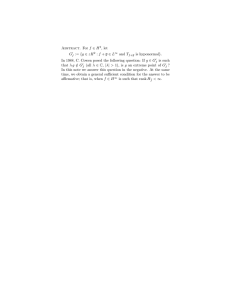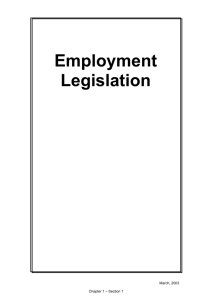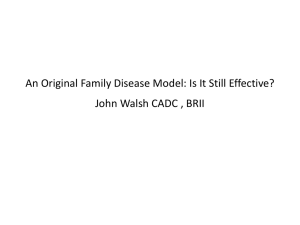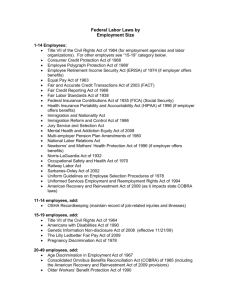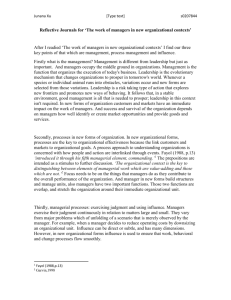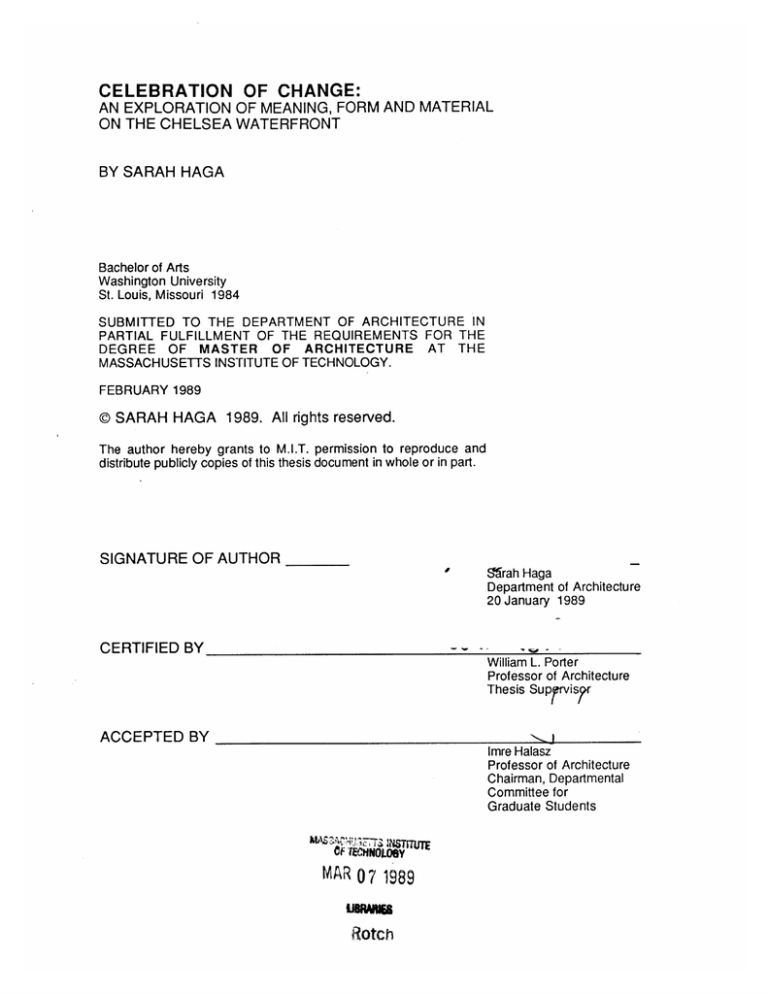
CELEBRATION OF CHANGE:
AN EXPLORATION OF MEANING, FORM AND MATERIAL
ON THE CHELSEA WATERFRONT
BY SARAH HAGA
Bachelor of Arts
Washington University
St. Louis, Missouri 1984
SUBMITTED TO THE DEPARTMENT OF ARCHITECTURE IN
PARTIAL FULFILLMENT OF THE REQUIREMENTS FOR THE
AT THE
DEGREE OF MASTER OF ARCHITECTURE
MASSACHUSETTS INSTITUTE OF TECHNOLOGY.
FEBRUARY 1989
© SARAH HAGA 1989. All rights reserved.
The author hereby grants to M.I.T. permission to reproduce and
distribute publicly copies of this thesis document in whole or in part.
SIGNATURE OF AUTHOR
Srah Haga
Department of Architecture
20 January 1989
CERTIFIED BY
William L. Porter
Professor of Architecture
Thesis Suprvisgr
ACCEPTED BY
N
I
Imre Halasz
Professor of Architecture
Chairman, Departmental
Committee for
Graduate Students
ASA USS
MNSTraffE
OF TECHiNOW.0Y
MAR 07 1989
Rotch
2
CELEBRATION OF CHANGE:
AN EXPLORATION OF MEANING, FORM AND MATERIAL
ON THE CHELSEA WATERFRONT
BY SARAH HAGA
SUBMITTED TO THE DEPARTMENT OF ARCHITECTURE ON
20 JANUARY 1989 IN PARTIAL FULFILLMENT OF THE
REQUIREMENTS FOR THE DEGREE OF MASTER OF
ARCHITECTURE.
ABSTRACT
Change as a physical and psychological process is the
connecting thread of the three themes explored in this thesis.
First, the AA* and Al-Anon* programs are used as a framework for
an exploration of spirituality or meaning. The programs are about
finding a route to positive change in one's life through a sharing of
common life experiences among group members. Second,
concrete is used as a primary structural and textural material and
as the point of departure for an exploration of all other materials.
The integration of material and form throughout the design
process was a basic premise. Finally, the strong character of the
site, on the waterfront, demanded investigation. The everchanging influences on the site generated the built form.
This document shows the project as a building process and a
design process.
The introduction clarifies the thematic origins
and intentions. A pictorial essay describes the design process.
Design production phases narrate the essay and act as a point of
reference for a chronological journal.
* Please reference Appendix One
THESIS SUPERVISOR: WILLIAM L. PORTER
TITLE: PROFESSOR OF ARCHITECTURE
3
4
TABLE OF CONTENTS
INTRODUCTION: MEANING
INTRODUCTION: CONCRETE
INTRODUCTION: SITE
7
11
13
PRODUCTION
PHASE I - SITE VISIT
PHASE II - RESEARCH
PHASE Ill - BUILDING PROGRAM
PHASE IV - DESIGN EXPLORATION
PHASE V - CONTEXT ANALYSIS
PHASE VI - PRELIMINARY DESIGN
15
21
25
39
41
53
59
DESIGN PROPOSAL
67
MEETING ROOM
85
ACKNOWLEDGEMENTS (THANKS TO:)
119
APPENDIX ONE
123
BIBLIOGRAPHY
125
5
6
INTRODUCTION: MEANING
The Twelve-Step programs, originating with Alcoholics
Anonymous (AA) represent, for me, a modern day search for
meaning.
Alcoholics Anonymous is a self-help movement for those afflicted
with the disease of alcoholism. It is centered around the Twelve
Steps:
1. We admitted we were powerless over alcohol - that our
lives had become unmanageable.
2. Come to believe that a Power greater than ourselves
could restore us to sanity.
3. Made a decision to turn our will and our lives over to the
care of God as we understood Him.
4.
Made a searching and fearless moral inventory of
ourselves.
5. Admitted to God, to ourselves and to another human
being the exact nature of our wrongs.
6.
Were entirely ready to have God remove all these
defects of character.
7. Humbly asked Him to remove our shortcomings.
8. Made a list of all persons we had harmed, and became
willing to make amends to them all.
9. Made direct amends to such people wherever possible,
except when to do so would injure them or others.
10. Continued to take personal inventory and when we
were wrong promptly admitted it.
11. Sought through prayer and meditation to improve our
conscious contact with God as we understood Him, praying
only for knowledge of his will for us and the power to carry
that out.
12. Having had a spiritual awakening as the result of these
steps, we tried to carry this message to alcoholics, and to
practice these principles in all our affairs.
12 STEPS REPRINTED WITH PERMISSION OF ALCOHOLICS ANONYMOUS
WORLD SERVICES INCORPORATED.
7
8
The core of the program is the meetings, loosely structured
gatherings of two or more members. Their purpose: to help the
alcoholic stop drinking and to give support for a new way of life.
Soon after the forming of AA in the 1940's a second Twelve-Step
Group, Al-Anon, was formed. Al-Anon is a fellowship for the
family and friends of alcoholics, the only requirement for
membership is that there is a problem with alcohol in a relative or
friend. Meetings in this group are similar in structure to those of
AA, providing a forum for members to share their experience,
strength and hope in order to solve their common problems.
In recent years many other Twelve-Step groups have started,
including NA (Narcotics Anonymous), OA (Overeaters
Anonymous) and many others. In this thesis AA or Al-anon were
the focus but the building was designed with service to all the
groups in mind.
Participation in any of the Twelve-Step programs suggests making
changes in one's life structure. For instance, if one's social life
revolves around drinking, part of being in AA is finding
replacement patterns. These changes often lead to a new sense
of community among members, analogous to those who focus
their lives around a church. This suggests the creation of a center
for the community to gather. For simplicity, the term Twelve-Step
Center is used in the thesis, although the groups listed above are
in fact separate entities with individual organizations and policies.
One of the policies they share is a tradition of not endorsing,
financing or lending their name to a related facility or outside
enterprise. The creation of a communal center, if implemented,
would be a facility independent of the programs of AA, Al-Anon,
etc.
The idea of designing one center, with all the groups in mind,
came from my belief that participants in the groups have a shared
theme, a search for change. What kind of place this Center should
be and what references it could draw from was the starting point of
my exploration.
9
10
INTRODUCTION: CONCRETE
Initially it was the mystique of the construction process which
attracted me to concrete. The time it takes for concrete to pass
from a liquid mixture of raw material to substance, a few hours, is
in striking contrast to the life expectancy of the finished product. In
a society increasingly focused on disposable materials, concrete
stands out as a modern material with many of the characteristics of
older building materials such as brick and stone. The use of these
traditional materials structurally has disappeared with the
introduction of steel. Concrete is currently the only material which
can be used economically for both enclosure and as a structural
bearing system.
The idea of combining a challenging architectural program with a
predetermined use of concrete evolved. The intention was to
expand on accepted views of concrete, especially as a textural
material. The design of a Twelve-Step Center offered a program
with the overlapping needs of spiritual expression and practical
considerations. The lack of specific references defining what such
a place could be suggested explorations of form which could only
be aided by a material with the paradoxical qualities of concrete.
11
12
INTRODUCTION: SITE
Chelsea became my home in June of 1988. The choice of a site
near my apartment was a natural as much of the initial thinking
about the thesis occurred on my deck overlooking the
neighborhood. A site on the waterfront came from the wish to
include water, natures most spiritual element and Boston's
greatest asset, in my thesis.
The Waterfront in Chelsea, a quarter mile beyond the North
abutment of the Tobin Bridge, is the site for my project. The site is
on the edge. The property boundaries enclose an area that is half
land, half water. Directly to the East of the site is a small
drawbridge connecting Chelsea and East Boston. To the North
and West are the remnants of a formerly Italian Chelsea
neighborhood.
The Site is about connection: between two cities, two pieces of
land. The site is about survival: the edge of Chelsea. It is about
going beyond, pushing on: the bridge leading to other places. It is
about existing fragments: the row houses dissected and severed
with time, the warehouses, abandoned, waiting for new use, facing
the last residential boat yard in Boston, the new concrete public
housing. It is about reclaiming land for direct use rather than
support uses like shipping and storage. It is about facing social
problems on their own turf: poverty and bars surround the site on
all sides.
13
14
PRODUCTION
The following
pages are a
summary of
the thesis
design process.
JOURNAL ENTRY JULY 18, 1988
Oh what thoughts I've
missed in
not writing
them down.
the last
weeks
15
16
SAGRADA
FAMILIA, DETAIL
Gaudi the
Visionary, pg .72
Descharnes, Robert
and Prevos, Clovis
JOURNAL
ENTRY
JULY 21,
1988
Visited the library this afternoon, just long
enough to check out a book on Gaudi. In his
introduction, Salvador Dali talks about Gaudi 's
natural casting process - direct from a tuft of
grass, a donkey......I want to do it.
17
SAGRADA
FAMILIA, UNDER
CONSTRUCTION
Gaudi the
Visionary, pg. 51
Descharnes, Robert
and Prevos, Clovis
JOURNAL ENTRY JULY 23, 1988
of stone and brick at the end of
Gaudi built
age. His famous building Sagrada Familia
their
was intended to be a continuous process building
worked over many centuries, as enduring a
it represented. The fact
project as the faith
is things were and are becoming more ephemeral.
is valued above a sense
Immediate gratification
of timelessness. Charging it to have something
now is more common than saving it to enjoy
18
later.
I
TRINITY
CHURCH,
BOSTON
From the Hancock
Tower Plaza.
JOURNAL
ENTRY JULY 23,
1988
Structures built to last indefinitely are
threatened by "disposable buildings". Trinity
Church in Copley Square is weakened on all
fronts: from below by the ever more frequent
rumble of the subway, from the side by a 50
story mirror, the fragile ego projection of one
man, by the air, whose constantly decreasing
quality bathes the surfaces of the building with
poison, from within as the faithful decrease and
the need for repairs goes beyond routine.
19
20
Production phase I
SITE VISIT
L
L
Aerial view of
Chelsea, East
Boston and
Charlestown, top.
View of the Tobin
Bridge from the
Southeast side of
the project site.
JOURNAL
ENTRY AUGUST
6, 1988
... .my first stab at identifying a site. I
walked around Chelsea, a small but incredibly
diverse place. The town is bound by the bay,
industry, the highway and poverty.
21
Production phase I
View of the Tobin
Bridge from the
southeast side of
the project site,
top.
Waterfront area of
Chelsea, bottom.
JOURNAL ENTRY AUGUST
6,
1988
I keep thinking that anything of importance in
Boston ought to have a view towards the water.
Being on the water implies being on the edge.
The program (of my thesis project) whatever it
evolves into, is about centering.
22
Production Phase I
t
Approaching the
project site from
Broadway,
downtown
Chelsea, middle.
View of Boston
Harbor from the
edge of the
project site,
bottom left.
View of Boston
from the channel
on the project
site, bottom right.
JOURNAL
ENTRY AUGUST
6,
1988
Community is about gathering. Can one be at the
edge and also gather?
A bridge on the other hand, is on the edge but
it is about connection because it is on the edge
of two things.
23
24
Production phase |1
RESEARCH
Cpr? 4E=C7-IoN(
TO
T-1E
crry
5 -T
I-A
5t?tN
A
TMA Ao-zi>L
IN6
.M-E
FAriL.'f
TwV(i rMo7A&
M E.
H-OMES
7 E_
-o(RA1
>r.N erTif
asT
T~~TC
t-\
tsesro
r-
-rcATYz
-
Ygrt
Relationship of
the project site to
the City of
Boston.
JOURNAL
ENTRY SEPTEMBER,
1988
The Waterfront is community property. Not just
physically but visually. The view belongs to
everyone. The building must respond to this.
25
Production phase I
~r
CITy
=
o-
=s=
1r~~
MI~L.,E
9^-J
5cxj
~ V-i
~
QC~L-U~ P~
E~
To
PDYw-'Tf -5r(rzlc-|C
AF
Relationship of
the project site to
the City of
Chelsea.
TA-f-46-7-
-~
-XE4r
TS
L
E
IP-Ar4
Production phase i
Ii
/
Relationship of
the project site to
the Chelsea
Waterfront
Neighborhood.
Production phase il
eI45A
-oe.
Tim
TZEE N FOfEMEN
OFEo
T
-5zes-rAND
3 L-L(L-Z>(
6,
4i-
First site analysis.
JOURNAL ENTRY SEPTEMBER,
1988
Views are critical
within the building. Only
views towards the water or views towards
internal spaces are truly private. North/South
orientation reduces the area available for
views.
28
1
-
Production phase 11
fl~
-
5Y
~-~- ~TZ
-i-A-L-iA-r-N4
A Tl4r
ri4O
v-
Ar-'0
L--1T
A-
ri+
.-
O
t5WCL-~ I:
Ew4--
rs --
-
IjO'-
~L?.
1--
rr
-;
4Ufl
W4A-5S 5LLY
CLL.. Q- VAr-AN-T r~wlL:,-N
WA,-rirZ-Fr-cT
Ar
A E- r 4
T=T-S(- A'.4e
L-EM41-r
g-WA-~z
At~
Ort-T
r-
F=A-M-ALLtE-.
lC>' C4-
I ?AL- t~.S
UH-i"-
tC)-e-
Br4-4->C
Oo r
iNV-sEE
rYTE
H ,& NO4Va-S-rMXr-AL.
rYO
A 0r T
T+f- N-lcr-
7a- E
-roT
+-F 4ZoN7A
History of the
Waterfront area
around the
project site.
29
Production phase I
-E:- -
jv
=F
,PE
.Xo0 Y
-I-.
1
Sketches of
Pembroke St.,
typical of the
Neighborhood.
30
1f.,ao
i-rU4
E li-.
-
41=-O S T,
L-i
7 O
~T M-
)
&46 * -- H--.. 4 I .4D Q
m
Production phase
I
Building on the
Waterfront around
Boston Harbor
1
31
Production phase Il
Ruin of frame
construction on
the East Boston
Waterfront.
JOURNAL
ENTRY SEPTEMBER 9, 1988
edge meeting water must be strongly
The built
reinforced from behind.
The edges must be guarded from leaks.
With what forms can a solid greet a liquid?
32
1
Production phase i
:/
Form exploration,
form work for
plaster cast,
imitating concrete
frame.
Scale: 1"=1'-0"*
JOURNAL ENTRY SEPTEMBER 9, 1988
form experiment which comes to mind is
The first
The second
looking at how water meets an edge.
The
edge.
an
meet
how
people
at
looking
is
edge.
an
meet
cars
how
is
third
33
Production phase |1
Form exploration,
chalk drawing of
concrete column
in plan.
JOURNAL
ENTRY SEPTEMBER 9,
1988
What form is suggested by the program (of the
building)? Words that come to mind are: Open,
acceptance, easy does it , gentle, one step at a
time, one day at a time. All these suggest
evolution rather than division. Relating this
back to the greeting of water with a solid mass,
An
the greeting should be friendly and open.
embrace rather than a handshake.
34
Production phase il
Material reference
Clark College
Library,
Worcester, Mass.
Archt. John
Johansen
JOURNAL ENTRY SEPTEMBER 9,
1988
In addition to user related concerns is an
interest in the connection of concrete to other
materials in relation to this design. For
example: what are the ways in which to connect
concrete and wood to:
create a window
make a seat
make a transition between
structural systems
36
Production phase i
/
Material
reference, detail,
. Clark College
iray
.............
... ........ Library,
Worcester, Mass.
Archt. John
Johansen
JOURNAL ENTRY SEPTEMBER 9, 1988
The choice of ways is unlimited but which ways:
make sense for a specific design
don't fail or leak
are most cost effective
are most visually and tactilely
pleasing
37
38
K
Production phase III
BUILDING
PROGRAM
FiJo!651rz-Ar
3r, ui-
t-l t-l 1T t-A E_ t--( T.-
i o re-
" tEi
0 > 3(:
FC-PU
~> ffo
>Z-o
£1
1-
-
)
Ten-Coo r
-Z-
- 1 rZo)(-I
0
7
5
-rllT-l
FiOr
1
~~4,~TT1K~67
o-o
o
b~3
do
69-
L-(T
D (-! 57-(
5ev-Tt zoo
(P) PAt T( -A
A~qKC3
-5
- -5
1P I c--
rc
-ro-rAL
40
Production phase IV
DESIGN
EXPLORATION
*
-
Initial sketches,
top and bottom
left.
Plaster site
model, bottom
right.
Scale 1/16"= 1'-0"
41
Production phase IV
Building on the
site.
Plaster site model
Scale 1/16"=1'-O"
42
1
Production phase IV
It
C
Form, building
program applied
to site plan.
Plaster site model
Scale 1/1 6"=1 '-0"
43
Production phase IV
.0
Form, detail
development,
form work for
. ..
plaster cast,
imitating concrete
building column.
Scale 1/16"=1'-O"
JOURNAL ENTRY SEPTEMBER 10, 1988
" The silhouette of a monument is born out of
structure, everything has a positive reason,
its
it
is repugnant to our intuitions
and, if a line
we do not work
in tracing a line
is not right;
(Gaudi The
solely by the power of rationality"
Visionary; DescharnesRobert and Prevost, Clovis)
44
w
Production phase IV
Form, detail
development,
plaster cast,
imitating a
concrete frame.
Scale: 1"=1'-0"
45
Production phase IV
Form, plaster cast
imitating concrete
frame, this page.
Scale 1"=1'-O"
Frame becomes
structure for
meeting room,
facing page.
Scale: 1/8"=1'-0"
m
.
b4
9
I
3:
Production phase IV
/
Form, built,
ink wash of
existing site
.
facing north
towards Chelsea
this page.
Same view with
image of project
meeting rooms
and communal
gathering space,
facing page.
/
_
JOURNAL
t' 0
ENTRY SEPTEMBER 15,
1988
Constructing the soul? Constructing the spirit?
My thesis is about expressing my soul, my spirit
and finding the universal soul and spirit.
The
method: from the ruins up.
48
Production phase IV
Form, built,
ink wash of
,
existing site
facing northwest
towards
Waterfront
Neighborhood,
this page.
Image of project
meeting rooms
along East side of
channel, facing
page.
50
T
JOURNAL ENTRY SEPTEMBER 15, 1988
After the sea wall, how does the building grow?
Traditionally, spirituality has been expressed
architecturally by larger than life dimensions.
Sometimes this is a vertical exclamation such as
a church spire or a minaret. Sometimes an awe
inspiring space such as St. Peters or the
Parthenon. Sometimes an awe inspiring object
such as the pyramids or a stupa. The purpose of
the Twelve Steps is not to inspire awe, but to
serve as a sanctuary and guide.
U'
52
V
7
Production phase V
CONTEXT
ANALYSIS
L
K
Existing site plan,
top.
City grid,
extended to the
project site,
bottom.
K
JOURNAL ENTRY OCTOBER 13, 1988
Creating bays within the channel is one way of
connecting the building to the larger waterfront
moves.
1
53
7]
Production phase V
I
F
Existing site plan,
top.
Existing angle at
which the water
meets the sea wall
of the channel.
This angle is
extended across
the project site,
bottom.
L
JOURNAL ENTRY OCTOBER 16, 1988
A direct attack upon this edge (the channel
The programs intention is
seawall) feels wrong.
This
with a new clarity.
to regard ones life
does not suggest cutting, but rather, a subtle
shaping or moulding of the edge.
54
Production phase V
(
Places for
building on the
project site, top.
Places of light on
the project site,
bottom.
JOURNAL
ENTRY OCTOBER 16, 1988
The essential feeling of attending an Al-Anon
meeting is security and safety.
If transitional
space is possible between the
everyday and the safety of the meeting, all the
better.
1
55
Production phase V
Combined effect
of the existing
influences on the
project site, this
page.
Plan generated
from analysis,
opposite page.
JOURNAL
ENTRY OCTOBER 16,
1988
The idea of regarding the original sea wall as a
reference point against which gentle impressions
and changes are measured is appealing.
56
4
~rn
V
L-- -
7
Xx,
~6
\\
,2-
'N
/
I,,
/
/
/
/
/
57
58
Production phase VI
PRELIMINARY
DESIGN
Plaster site model
Scale 1/16"=1'-0"
JOURNAL
ENTRY OCTOBER 16,
1988
Al-Anon and AA are about reaching out to one
another in a hug.
59
/
Production phase VI
View of the
project from the
water.
JOURNAL ENTRY OCTOBER 17,
1988
.the recurring theme of the river in Siddhartha
which represented both change and a constant led
to a realization that the common thread in
places people turn to for guidance is change.
Institutional buildings, churches, government
offices and schools, in past times, were built
for eternity, summer, winter, regardless of the
site, they stood steadfast oblivious to time and
social change.
.
60
Production phase VI
View of the
project from
Chelsea looking
towards East
Boston and the
Boston Harbor.
JOURNAL ENTRY OCTOBER 17, 1988
The Twelve-Step programs are about stability but
stability arrived at by change.
project) should have an
This place (the thesis
A layering as in the
change.
of
under-current
built over time
were
They
old cathedrals.
because the magnitude of design was more than
one generation could build. So, they became a
The layering gave reference
collage of parts.
to the past.
62
4m
.4
I
'S
I/
Io
ii
IN
-W
Production phase VI
A
Niight time views
of the project
from the water.
JOURNAL ENTRY OCTOBER 17, 1988
People came to these (institutional buildings)
places seeking either the status quo or a sense
of universal timeless guidance. Suddenly in
age, people are embarking on personal
this
crusades. Seeking change within themselves and
in the world around them. How can architecture
respond to this? Representing change is not
necessarily about flexibility, rather it is
about response.
64
66
DESIGN
PROPOSAL
On the following
pages are the
plans, elevations
and sections as
a summary of the
final phase of
design.
JOURNAL
ENTRY OCTOBER 20, 1988
Rooms I would like to be in. How one gets there
is as important as the there.
67
EXISTING SITE
PLAN, COMPLETE
THIS PAGE
EXISTING SITE
PLAN, PARTIAL
FACING PAGE
68
G
K
CD
ELEVATION
(GROUND) CUTS
AND FOUNDATION
PLAN, COMPLETE
THIS PAGE
ELEVATION
(GROUND) CUTS
AND FOUNDATION
PLAN, PARTIAL
FACING PAGE
70
1.
l(O
BUILDING AND
SITE PLAN
THIS PAGE
BUILDING PLAN,
FIRST FLOOR
FACING PAGE
72
a-
p5
73
.
.
4
...
CIRCULATION
DIAGRAM, FIRST-0
FLOOR
THIS PAGE
BUILDING PLAN,
SECOND FLOOR/:E.:
FACING PAGE
74
...
e
--
i
+:-
-
0
1
.1
MTG. ROOM *
0
0
/MT&r. ROOM
75
SECTION, WEST
WING, COMPLETE
THIS PAGE
SECTION, WEST
WING, PARTIAL
FACING PAGE
76
LI
7;4ri
LI
~I
Iz
CHANNEL
ELEVATION,
COMPLETE
THIS PAGE
CHANNEL
ELEVATION,
PARTIAL
FACING PAGE
j/I~
II]
D
D
WINNISIMMET
STREET (WEST)
ELEVATION,
COMPLETE
THIS PAGE
WINNISIMMET
STREET (WEST)
ELEVATION,
PARTIAL
FACING PAGE
80
Dsamaam
WILLIAMS STREET
(NORTH)
ELEVATION,
COMPLETE
THIS PAGE
WILLIAMS STREET
(NORTH)
ELEVATION,
PARTIAL
FACING PAGE
82
rr
IDE
in I
FT
11
>i
lA
84
MEETING
ROOM
On the following
pages are a series
of photo's
showing a model
of one of the
smaller meeting
rooms in the
project. The
intention is to
suggest what the
building might
feel like.
JOURNAL
ENTRY OCTOBER 23,1988
The experience of an Al-Anon meeting is unlike
anything else.
Each meeting is unique but the
program is the guiding theme which connects them
all.
As I designed I made decisions on what a
meeting space should feel like based on my own
impressions gathered from a large variety of
meetings.
To help understand the design it is
important that I articulate that generalized
meeting I hold in my mind.
85
JOURNAL
ENTRY OCTOBER 23,
1988
The first
part of the experience is the decision
to attend a meeting.
The physical location of
the meeting enters into this mainly based on how
accessible the site
is.
However subtler
physical influences could affect the decision if
a particular meeting has been attended before.
For example, at one meeting I have been to there
is a lack of acoustical privacy which is
disturbing
86
meeting.
to many people who attend
the
JOURNAL
ENTRY OCTOBER 23,
1988
Arriving at the location is generally unnerving.
The meetings are listed by street address and
because they are often held in hospitals,
churches or other large institutions it can be
difficult to find the meeting room.
88
...
..
..
..........
..
..
...
I9H
:
a
JOURNAL
ENTRY OCTOBER 23, 1988
Meetings are places of intense personal sharing.
The physical
environment must relate
to
this
by
providing some basic supports. Privacy, related
to anonymity and safety is essential.
90
m
JOURNAL ENTRY OCTOBER 23,
1988
Once the room is found the next hurdle is
entering a room full
of strangers. The standard
format of the meetings helps one feel at home,
even at a meeting one has never attended before.
92
.3I
94
JOURNAL
ENTRY OCTOBER 23,
1988
Meetings are structured with a formal opening
read aloud by a person selected to "chair" the
The opening is a simple statement of
meeting.
welcome, a mention of the purpose of Al-Anon
followed usually by a reading of the Twelve
Steps.
Everyone then introduces themselves, by their
first
names only, for
the sake of
anonymity.
The
chair-person shares a personal story always
Then the meeting is
relating it to the program.
opened for all to share their own experiences
usually related to a topic the Chair-person has
chosen or to one of the Twelve-Steps.
96
JOURNAL
ENTRY OCTOBER,
1988
It is very frustrating to summarize on paper the
experience of a meeting which is about feeling.
Writing a poem seems more appropriate.
Fear, doubt, insecurity.
Indecision, mind games, worry.
I need a meeting.
No time,
go.
things to do, people to see, places to
I need a meeting.
It
is
cold out tonight, the bus is
parking's
a drag,
a pain...
I need a meeting.
Ok
Lets see, 6:00pm, 123 Anywhere.
I'm here but where is
the meeting room?
People, voices, through the door.
Safety.
Turning off
98
Relaxing.
my head, turning
on my feelings.
JOURNAL
ENTRY NOVEMBER 1, 1988
that a
I have explored the idea in my thesis
The
place for change should suggest change.
architecture of a place can do this by
responding to the physical changes which
naturally occur such as the weather, the tides,
The Center
the sun and most importantly: time.
was designed to have an undercurrent of change.
100
JOURNAL
ENTRY NOVEMBER 1,
1988
The time of day can be seen in the height of
the piers.
The age of glass can be visually estimated by
the change in the width of the bottom of the
pane.
102
JOURNAL
ENTRY NOVEMBER 1,
1988
The amount of rain falling
is best measured by
the number of streaks left on the concrete
surface.
104
JOURNAL ENTRY NOVEMBER,
The Places
Between
1988
Spontaneous conversations.
A cigarette break.
A hug.
A place to cry.
A place
to reflect
in
private.
A chance to encounter change.
106
JOURNAL
ENTRY NOVEMBER 1, 1988
The rooms are places of great safety.
Feeling secure is a physical sense of
confidence.
108
JOURNAL
ENTRY NOVEMBER
1,
1988
Being safe is knowing the boundaries of the
space one is inhabiting.
Safety can be suggested by form.
Security can be textural.
110
JOURNAL
ENTRY NOVEMBER 7,1988
Anonymity. Our society does not yet encourage
reaching out as a way of dealing with problems.
We are still
trapped in the stiff
upper lip
trap
of private sorrow and pain. Alcoholics,
overeaters and those dependent on drugs are seen
as having a problem but, more destructive for
them, they are expected to deal with their
problem on their
own.
112
JOURNAL
ENTRY NOVEMBER,
1988
It is only recently that people have started
being educated to the concept that these
problems are actually addictive diseases for
which the persons affected are not to blame.
a
society
however,
we are still
far
As
from
accepting or even more importantly encouraging
people to deal with their diseases. As a
result,
it is important to all people involved
in the twelve-step programs that they remain
114
anonymous.
116
*1
118
I
7
-F
1 THANK
YOU ALL:
My Parents:
Juola and Patricia
Haga
My Sisters:
Alexandra and
Antonia Haga
I
L
A
-V__
L
L
My Grandparents:
Clifford and Mary
Haga
My Advisor:
William L. Porter
My Readers:
Eric Dluhosch
Damon Strub
Mark Kucirka
The Girl Talk
Group:
Maria D.
Lauren W.
Janina M.
My Friends:
Monica and
Elliott S.
-j
-
Betsy W.
Steven M.
James B.
Sarena H.
Diane M. and
family
Sharon H.
Moezzedin K.
Leon G.
Jennifer M.
Mike S. and
family
The guys in
California
119
'I'%~Th~
~'
., I, ctxcvae.
C'm-oit,
p .I
f SrAMI
. WitrtteVA
51tal1 o
platowrie
120
Ii
rF
11h1A
-.
*1~
LM
II,
SCOTT KUCKLER
PHOTOGRAP
1
E.
-- 121
122
APPENDIX ONE
AA PREAMBLE
Alcoholics Anonymous is a fellowship of men and women who
share their experience, strength and hope with each other that
they may solve their common problem and help others to recover
from alcoholism.
The only requirement for membership is a desire to stop drinking.
There are no dues or fees for A.A. membership; we are self
supporting through our own contributions. A.A. is not allied with
any sect, denomination, politics, organization or institution; does
not wish to engage in any controversy; neither endorses nor
opposes any causes. Our primary purpose is to stay sober and
help other alcoholics to achieve sobriety.
Preamble reprinted with permission of the AA Grapevine.
AL-ANON PREAMBLE
The Al-Anon Family Groups are a fellowship of relatives and
friends of alcoholics who share their experience, strength and
hope in order to solve their common problems.
We believe
alcoholism is a family illness and that changed attitudes can aid
recovery.
Al-Anon is not allied with any sect, denomination, political entity,
organization or institution; does not engage in any controversy;
neither endorses nor opposes any cause. There are no dues for
membership. Al-Anon is self-supporting through its own voluntary
contributions.
Al-Anon has but one purpose: to help families of alcoholics. We
do this by practicing the Twelve Steps, by welcoming and giving
comfort to families of alcoholics, and by giving understanding and
encouragement to the alcoholic.
Preamble reprinted with permission of Al-Anon Family Group Headquarters,Inc.
In this thesis AA and Al-Anon are referred to as Twelve-Step
groups.
The Twelve Steps are only a part of each groups
program.
Information on the groups included here should be
regarded as a selective introduction to the programs, rather than
an inclusive description.
123
124
BIBLIOGRAPHY:
Al-Anon Family Group Headquarters, "Al-Anon Family Groups",
New York: Al-Anon Family Group Headquarters, 1987
Bill, James A., "Emotion, Myth and Meaning in Architecture:
Psyche's Journey Through a Warehouse" MIT M.ARCH Thesis,
1988
Bruun, Erik and Popovits, Sara, "Kaija and Heikki Siren
Architects", Helsinki: The Otava Publishing Co. 1977
Descharnes, Robert and Prevost, Clovis, "Gaudi The Visionary",
New York: The Viking Press, 1982
Hesse, Hermann, "Siddhartha", New York: Bantam Books, 1981
James, Cary, "Frank Lloyd Wright's Imperial Hotel" New York:
Dover Publications Inc. 1988
125

